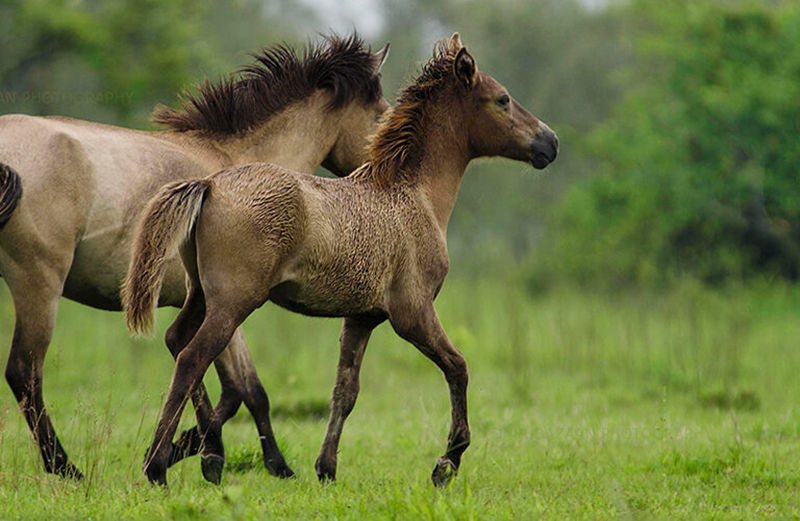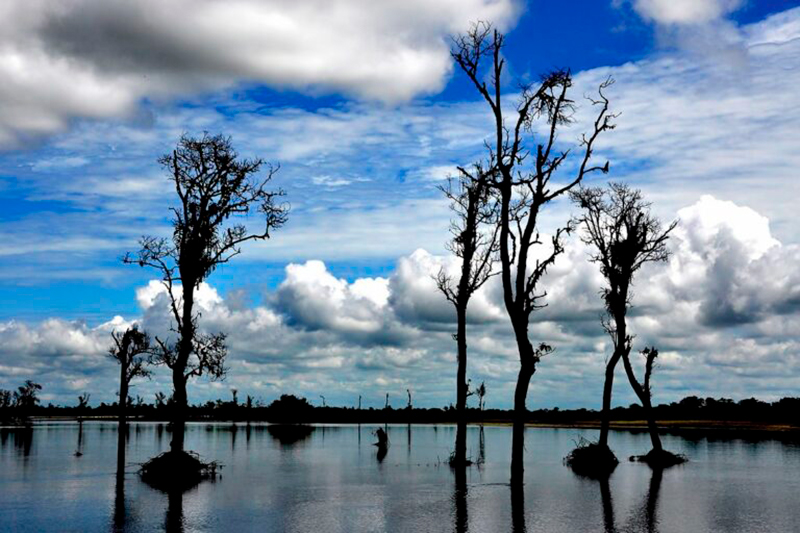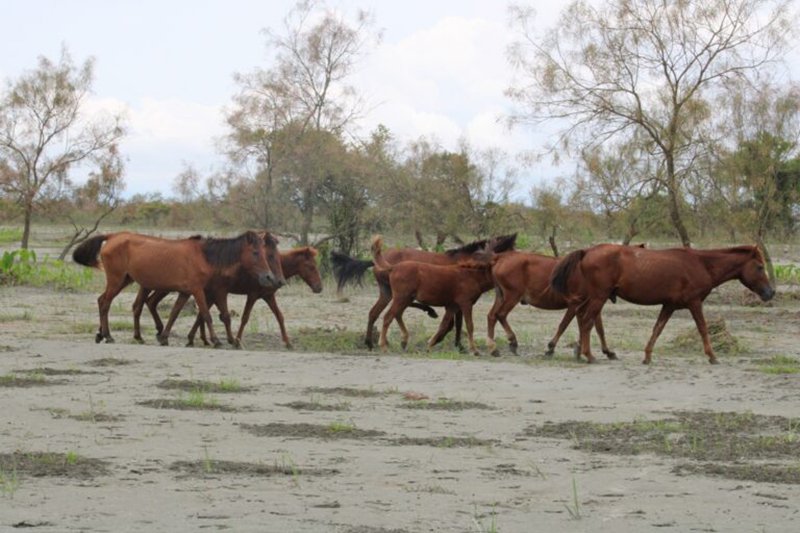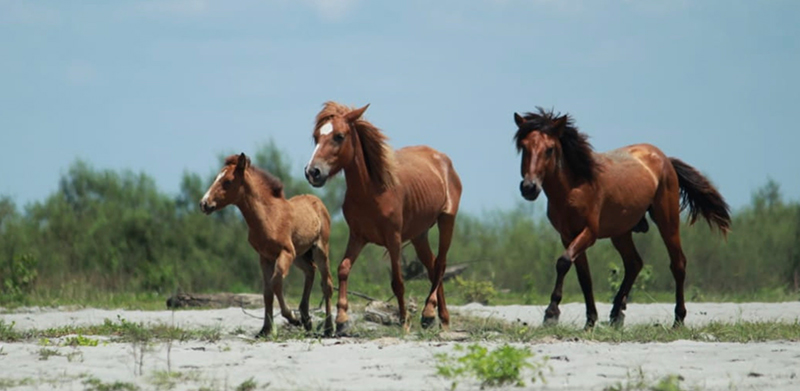 Feral Horses
Feral Horses
The last feral horses of India
The Dibru Saikhowa National Park in Assam is the only place in India with a population of feral horses. These horses are believed to be descendants of war horses from World War II, while other theories suggest they could be descendants of China’s Przewalski’s horses. The horses face threats from smuggling and dwindling grazing grounds and habitat. Mongabay-India correspondent Nabarun Guha reports
In February 2020, right before the COVID-19 pandemic induced a country-wide lockdown, the Tinsukia Wildlife Division made a major breakthrough. Based on a tip-off, the forest officials apprehended a truck near Makum bypass in the Tinsukia district of Assam which, say the forest officials, was transporting six smuggled feral horses.
“We caught four people, including two army personnel, with the consignment. Their papers (documents approving the transport of horses) were forged. We came to know that the kingpin of this smuggling ring was a high-ranking Indian military officer who gave riding lessons in Guwahati. The horses were procured from Dibru Saikhowa National Park and were kept in an under-construction hospital in Laupoti, Phulbari village in Tinsukia, before being sent off to Guwahati in the truck,” said a forest official on conditions of anonymity.
The six horses were later released in Dibru Saikhowa National Park.
Dibru Saikhowa was declared a reserve forest in 1890, and more than a century later, in 1999, it acquired the status of a National Park. Around 12 kilometres from the town of Tinsukia, Dibru Saikhowa National Park is bound by the mighty Brahmaputra and Siang rivers on the north, Lohit, Dibang and Noa Dihing rivers in the east and Dibru river in the south.
With an area of 340 square kilometres, the national park is known for its impressive faunal diversity with rare and endangered mammals such as elephants, wild buffaloes, hoolock gibbons and Gangetic river dolphins. Feral horses, however, are one of the most prized inhabitants of the park, as this is the only place in India where they are found.
 Dibru Saikhowa National Park. Image by Dhruba Jyoti Baruah via Wikimedia Commons (CC BY-SA 4.0).
Dibru Saikhowa National Park. Image by Dhruba Jyoti Baruah via Wikimedia Commons (CC BY-SA 4.0).
Point Calimere in Tamil Nadu also has a population of wild horses, but feral horses are only found in Dibru Saikhowa.
The main difference between wild horses and feral horses lies in their ancestry. Unlike feral horses, wild horses haven’t descended from domesticated horses.
However, without any effective conservation strategies in place, feral horses face threats from smuggling and are also gradually losing grazing grounds and habitat to floods and livestock.
The origin story
Feral horses are free-roaming horses that descended from a domesticated stock. But they have lived in the wild for almost 80 years in Dibru Saikhowa.
According to a 2021 study published in the Open Journal of Bioresources, “Feral horses mostly prefer grassy river flats, forests and woodlands. They use open areas where predators can be seen from a distance. They are found within a 5–6-kilometre range of water sources. Some of the areas in Dibru Saikhowa where feral horses are found are Churke Tapu, Arna Tapu, Kathalkuthi near Mieli Camp, Kobu Chapori.”
There are multiple theories about the origin of the feral horses in the region. The most popular one is that these horses are descendants of the ones used by the Allied forces against the Japanese in World War II.
“It is said that the British and American troops left these horses behind after the war ended. The feral horses found here [now] are the third or fourth generation of those horses. However, there is no written record to support this theory,” K.N. Das, Divisional Forest Officer (DFO), Tinsukia Wildlife Division, tells Mongabay India.
The theory is supported by the fact that Tinsukia served as an important battleground on the eastern front during World War II. Ledo, which is around 67 kilometres from Dibru Saikhowa, had an airstrip built by the American soldiers, while another nearby town called Margherita had a military hospital to treat the wounded soldiers.
Shamikhu Changmai, one of the authors of the 2021 study, also supports this theory. “Following the great earthquake in Assam in 1950, the rivers changed course, and many of these feral horses got trapped in Dibru Saikhowa. Now, they are mostly seen in chaporis (sandbars),” he adds.
According to noted environmentalist Anwaruddin Choudhury, these horses are descendants of cart horses found in the area in the 1940s.
“Horses were used for carrying goods in World War II. These horses mainly belonged to the people from the Bihari community settled in Tinsukia at that time. Some of them went back to their native place after the war, leaving behind the horses which migrated to the nearby forests of Dibru Saikhowa, which was a reserve forest then,” he shares.
 Feral horses on sandbars in Dibru Saikhowa. Image by Shamikhu Changmai.
Feral horses on sandbars in Dibru Saikhowa. Image by Shamikhu Changmai.
Tourist operator and environmentalist Niranta Gohain, however, refutes the World War theory and claims that these horses are descendants of Przewalski’s horses, considered the only remaining wild horse species in the world.
“These Przewalski’s horses travelled from Xinjiang province in China to Tinsukia and settled here. Till now, there has been no study to find the correct lineage of these horses. I demand genetic study of the horses so that their proper origin can be known,” says Gohain.
Surrounded by threats
After the incident in 2020, there have been no reports of organised smuggling of feral horses from Dibru Saikhowa. However, local sources claim that stray smuggling of horses occurs occasionally.
DFO Das, however, denies these allegations. “During my tenure, I haven’t heard of any smuggling incident of feral horses,” he says.
Rajendra Bharti, the former DFO, had led the operation that had caught the gang smuggling the feral horses in 2020. He denied comment about the incident, citing it as an ongoing judicial matter.
On conditions of anonymity, a forest official told Mongabay India that since feral horses are not granted any protection under the Wildlife Protection Act of 1972, they are still not considered wild animals. “So, even if we arrest somebody in this regard, it is very difficult to get a conviction,” he says.
Additionally, there has been no regular census of the horses which makes it challenging to ascertain their conservation status. “As per the last census done seven years ago, Dibru Saikhowa had 400 horses,” says DFO Das.
Changmai said that as per his field study research, there are 150-200 feral horses in Dibru Saikhowa presently.
“Annual flood and erosion pose a severe threat to the horses. Every year, quite a few horses are swept away in the floods. Apart from that, various human activities and cattle farms from nearby forest villages degrade their habitat. In fact, domestic cattle are their major grazing competitors. These horses live in herds of 3-5 individuals and sometimes upto 12-15 individuals. On many occasions, these horses are found near cattle farms known as khuties for grazing and also to lick salt,” he shares.
Anwaruddin Choudhury claims that the decrease in the tiger population in Dibru Saikhowa has boosted the population of feral horses to some extent. “In the 90s, there were a sizable number of tigers in Dibru Saikhowa. These feral horses were easy prey for the big cats. Now, there are hardly any tigers in Dibru Saikhowa. So, the number of these horses has increased.”
The allure of feral horses
It can’t be denied that feral horses attract tourists to Dibru Saikhowa, being the only of its kind in India. However, over the years their attraction has dwindled.
“It is actually a costly affair for tourists to see feral horses. These horses live in secluded sandbars. It takes around a day to reach those places from the main entry point of the park in Guijan. Boats are the only mode of transport and renting a boat costs around Rs. 15,000. Moreover, feral horses are shy animals, and there is no guarantee that tourists will get a good look even if they go near those sandbars,” shares Hiren Senapati, a local tourist guide in the area.
Das clarifies that the feral horses are not the main attractions of Dibru Saikhowa. “We get a lot of birders from across the world. Also, many people just come here to get a feel of the forest,” he says.
 Feral horses running in the sandbars (chaporis) in Dibru Saikhowa National Park in Assam. Image by Hiren Senapati.
Feral horses running in the sandbars (chaporis) in Dibru Saikhowa National Park in Assam. Image by Hiren Senapati.
Changmai, however, feels that tourism at Dibru Saikhowa can benefit from the horses.
“However, we need to provide due attention to these animals. Currently, I am doing a study on feral horses funded by the Indian Space Research Organization (ISRO). It is a geospatial study of the ecology of these horses. We need proper scientific research on the soil condition and availability of food and water in the habitat of these horses. At the same time, we need to create mass awareness about them so that they are not neglected anymore,” he says.
Senapati opines that though there may not be much interest in these horses at the moment, they will always remain an important part of the Dibru Saikhowa National Park. He says, “When a herd of these horses gallops across the green meadows with the river Brahmaputra forming the background, few images can rival its beauty.”
The article was originally published in Mongabay India.
Mongabay India/TWF
Support Our Journalism
We cannot do without you.. your contribution supports unbiased journalism
IBNS is not driven by any ism- not wokeism, not racism, not skewed secularism, not hyper right-wing or left liberal ideals, nor by any hardline religious beliefs or hyper nationalism. We want to serve you good old objective news, as they are. We do not judge or preach. We let people decide for themselves. We only try to present factual and well-sourced news.







